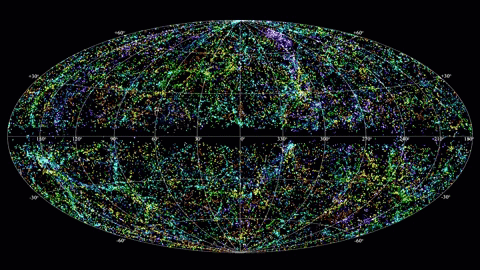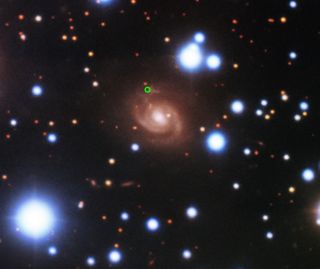
HONOLULU — Mysterious ultra-fast pinpricks of radio energy keep lighting up the night sky and nobody knows why. A newly discovered example of this transient phenomenon has been traced to its place of origin — a nearby spiral galaxy — but it's only made things murkier for astronomers.
The problem concerns a class of blink-and-you'll-miss-them heavenly events known as fast radio bursts (FRBs). In a few thousandths of a second, these explosions produce as much energy as the sun does in nearly a century. Researchers have only known about FRBs since 2007, and they still don't have a compelling explanation regarding their sources.
"The big question is what can produce an FRB," Kenzie Nimmo, a doctoral student at the University of Amsterdam in the Netherlands, said during a news briefing on Monday (Jan. 6) here at the 235th meeting of the American Astronomical Society in Honolulu, Hawaii.
Related: The12 Strangest Objects in the Universe
Scientists were given some help in 2016, when they discovered an FRB that repeated its quick-pulsing radio tune in random bursts. All previous examples had been one-off events.
The repeating FBR was eventually traced back to a dwarf galaxy with a high rate of star formation 3 billion light-years away, Nimmo said. The galaxy contains a persistent radio source, possibly a nebula, that could explain the FRB's origin, she added.
Astronomers have also managed to determine that three non-repeating FRBs came from distant massive galaxies with little star formation going on. This seemed to provide evidence that repeating and non-repeating FRBs arose from different types of environments, Nimmo said. But the new discovery challenges this simple story.
Get the Space.com Newsletter
Breaking space news, the latest updates on rocket launches, skywatching events and more!
FRB 180916.J0158+65, as the object is known, is a repeating FRB discovered by the Canadian Hydrogen Intensity Mapping Experiment (CHIME) observatory, a radio telescope near Okanagan Falls in British Columbia that Nimmo called "the world's best FRB-finding machine."
Follow-up observations by a network of telescopes in Europe allowed the research team to produce a high-resolution image of the FRB's location. This location turned out to be a medium-sized spiral galaxy like our Milky Way that is surprisingly nearby, only 500 million light-years away, making it the closest-known FRB to date. The results were published yesterday (Jan. 6) in the journal Nature.

Despite precisely locating the FRB, the team was unable to detect any radio sources in the spiral galaxy that could explain the mysterious outbursts. Even worse, this new entity seems not to fit the patterns established by previous repeating and non-repeating FRBs.
Related: The 15 Weirdest Galaxies in Our Universe
"This is completely different than the host and local environments of other localized FRBs," Benito Marcote, a radio astronomer at the Joint Institute for VLBI European Research Infrastructure Consortium and lead author of the Nature paper, said during the news briefing.
The researchers hope that subsequent data might help them get a handle on what this FRB is telling them. But until then, they might have to continue scratching their heads over these puzzling phenomena.
- Cosmic Record Holders: The 12 Biggest Objects in the Universe
- 15 Amazing Images of Stars
- The Biggest Unsolved Mysteries in Physics
Originally published on Live Science.

Join our Space Forums to keep talking space on the latest missions, night sky and more! And if you have a news tip, correction or comment, let us know at: community@space.com.

Adam Mann is a journalist specializing in astronomy and physics stories. His work has appeared in the New York Times, New Yorker, Wall Street Journal, Wired, Nature, Science, and many other places. He lives in Oakland, California, where he enjoys riding his bike. Follow him on Twitter @adamspacemann or visit his website at https://www.adamspacemann.com/.
-
rod ReplyAdmin said:Mysterious ultra-fast pinpricks of radio energy keep lighting up the night sky and nobody knows why.
Origin of Deep-Space Radio Flash Discovered, and It's Unlike Anything Astronomers Have Ever Seen : Read more
"The problem concerns a class of blink-and-you'll-miss-them heavenly events known as fast radio bursts (FRBs). In a few thousandths of a second, these explosions produce as much energy as the sun does in nearly a century. Researchers have only known about FRBs since 2007, and they still don't have a compelling explanation regarding their sources."
Very interesting, FRBs produce enormous energies. This suggest the universe is filled with catastrophic processes at work that is hostile to life on Earth - like the FRB sources were much closer. Reports like this suggest the universe astronomers see today is winding down-not up. -
Ted How much energy is released at the precise moment when those alien ships cross the threshold from normal to FTL drive during acceleration or deceleration? o_OReply -
indigoredster If you want to send a message containing information to light-distant listeners, you need to compress the information in time to extremely fast datum bursts so that they will be slowed and still decipherable, due to time dilatation in relativity, to a readable/decryptable rate at reception possibly eons later. That's why we should expect fast bursts that hopefully we can translate to something we can comprehend.Reply -
Deleola Maybe this video I shot on a fishing trip could explain or offer an insight into this Deep Space Radio Flash. Sparkles of light on the sea.Reply -
John_Smith An intergalactic war is going on in galaxy SDSS J015800.28+654253.0Reply
Entire solar systems are being wiped out, including their inhabitants.
Cross your fingers they haven't noticed us yet. -
indigoredster Reply
That's exactly what the burst message says..... problem is it ended a long time ago ;-)John_Smith said:An intergalactic war is going on in galaxy SDSS J015800.28+654253.0
Entire solar systems are being wiped out, including their inhabitants.
Cross your fingers they haven't noticed us yet. -
Ryan F. Mercer Replyindigoredster said:That's why we should expect fast bursts that hopefully we can translate to something we can comprehend.
-
Admiral Lagrange Replyrod said:"The problem concerns a class of blink-and-you'll-miss-them heavenly events known as fast radio bursts (FRBs). In a few thousandths of a second, these explosions produce as much energy as the sun does in nearly a century. Researchers have only known about FRBs since 2007, and they still don't have a compelling explanation regarding their sources."
Very interesting, FRBs produce enormous energies. This suggest the universe is filled with catastrophic processes at work that is hostile to life on Earth - like the FRB sources were much closer. Reports like this suggest the universe astronomers see today is winding down-not up.
They're just LEDs burning out in our virtual universe.

